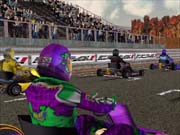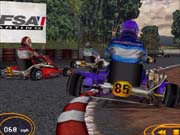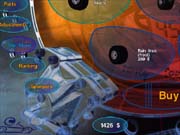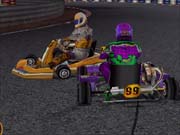Talk to a professional racecar driver, and chances are he'll tell you he got his start in a go-kart. Not the three-horsepower retooled lawn mower you'll find in an amusement park, mind you, but a lighting-quick ground-hugging racing kart. Curiously, PC racing game developers have largely ignored karting, instead focusing on the rarified environments of Formula 1 or NASCAR. One of the very few companies to even offer a kart-based game is Montreal's Microids, which has just released Open Kart, a promising and feature-packed racing game that regrettably suffers from unsophisticated physics, limited difficulty, and potential instability. If you're a veteran PC racer, Open Kart is one of those games you'll really want to like and will undoubtedly enjoy for a few hours. However, odds are that you'll ultimately find it disappointing.

Open Kart is a big and outwardly impressive game. When you first boot the program, you'll immediately be struck by the quality of the opening animation, the slick look of the interfaces, and the depth and intuitiveness of the menu screens. A battery of graphic, audio, and control options is available to tailor the game to the speed of your computer and your preferred style of driving, and a massive variety of racing modes seems ready to cater to virtually every skill level. Career mode grants entrance into an entire world of racing, wherein you'll purchase and sell parts, experience the intricacies of the garage, and learn how to modify your aggression in accordance with the current balance of your bank account. Arcade mode allows you to instantly and randomly compete on one or any combination of the game's tracks without first submitting to the setup and general maintenance complexities of a full career. Time attack mode places you alone on the track, where your only company is the faithfully recorded ghost image of your last lap. Multiplayer lets you race with other friends or foes, although it does not offer a split-screen option for single computer play or a dedicated server for Internet competition, and thus is quite restrictive.
Sadly, the game is not nearly as versatile as it first appears. The physics model, for example, differs almost imperceptibly from arcade to career modes and therefore affords little variance for those who might prefer a more strenuous or less taxing ride. The game's level of difficulty is preset and unalterable, thereby forcing you to contend with the same quality of artificial intelligence and physics from beginning to end. An even bigger problem lies in the way Microids designed its driving model. Simply put, an Open Kart kart just doesn't feel like the real thing. They'll glide instantly across the track with just a touch of the joystick, yet exhibit wheel spin only when pushed beyond all reasonable limits. Drifting your rear tires through a sharp turn seems more like a gravity-defying maneuver than a planned loss of adhesion, braking is strangely free of lockups and skids, and spinouts occur only when a fellow competitor tags you hard on the rear corner.

Yet although the ride is simplistic and clearly leans toward arcade rather than simulation, it is not necessarily unpleasant. In fact, your miniature racer won't fail to dazzle you with its snappy acceleration, rocketing top speeds, and agile cornering. The game features such advanced factors as high-speed slipstreaming and rewards those who adopt authentic cornering trajectories and early braking techniques. The inclusion of "carb blocking" is particularly impressive, where drivers temporarily impede the carburetor's air intake during the deceleration phase in order to achieve a short performance boost down the next straightaway. As players will soon see, the AI drivers do it all the time.
Indeed, the Open Kart computer drivers are generally quite believable. They'll usually move sensibly about the track, each car realistically handling some sections better than others and thus gaining and losing ground in a repetitive but realistic fashion. Rarely will they perform a physics-defying maneuver just to get by you, nor do they exhibit that annoying pace equalization routine favored by some racing games, wherein the competition magically matches your own current speed. They will, oddly enough, smack into you at the start of an event and become rather aggressive through tight turns, but real-world karting is likewise fraught with contact.

Regardless, the indisputable centerpiece of Open Kart is its career mode, and it is here that Microids has really gone to town. You'll open your career as the proud owner of a junior-level 100cc kart, which will accompany you on a series of seven sub-five-minute events that consist of individual training, qualifying, and race sessions. Your immediate goal is to win the 100cc championship and then move on up the ladder to the 125cc and prestigious 250cc classes, each of which offers a distinctly faster and more dangerous driving experience. The game's tracks are quite varied, running the gamut from flat indoor temporary circuits and longer purpose-built outdoor facilities to undulating mountain courses and city street environments. Yet they all share several commonalities, the most obvious of which is an obvious fondness for twists and turns. If you don't enjoy thrashing your joystick back and forth, Open Kart is not for you.
Along the way, you'll be forced to repair or replace many of the same parts as a real kart driver. This will require money, of course, which you'll accumulate through prize winnings, the sale of old parts, and the corporate sponsorship that is inevitably drawn to a good wheelman. Unlike in Ratbag's Dirt Track Racing series, you aren't permitted to accept and refuse sponsor offers, but you will lose support if you don't continue to finish strongly. All modifications, whether implemented through new parts or tweaks to already existing components, subtly and realistically affect your car's performance one way or another. That's a good thing, as is the manner in which your vehicle incurs damage. Plowing head-on into a barrier or opponent will negatively impact the frame, tires degrade according to their composition and pressure, and extended carb blocking wreaks havoc on the motor.
Unfortunately, none of the worn or bent parts are depicted graphically. Indeed, your kart will appear to remain in showroom condition regardless of the carnage you've put it through. Otherwise, the game presents a detailed and downright busy environment and a copious amount of scenery. And that's as it should be, because Open Kart features just 14 total circuits, seven of which are merely variants of other tracks. Fans of high-resolution racing should take particular care, as the frame rate tends to jump sometimes when the screen gets busy. On a more positive note, the game sports wonderfully rendered vehicles, several cute driver animations, and a nifty multiple-camera replay. The racing audio is satisfactory, although brake effects are curiously absent and the tire squeal is buried deep in the mix.

Yet the most damning aspect of the game is the apparent ease with which is can be beaten. Any PC racer worth his or her weight in spare parts should complete the entire career in a single day. Whether blame can be placed on the short race distances or the decidedly easy competition is open for discussion, but you'll rarely be compelled to access the garage or revert to a saved game to get the job done. Indeed, most saved games will be used to salvage a career that has ended prematurely during one of Open Karts' seemingly unavoidable program crashes.
Despite flashes of brilliance and a solid concept, Open Kart is an uneven proposition that is too fleeting for most and too simplistic for serious simulation buffs. That it crashes on occasion is one more reason it cannot be highly recommended.